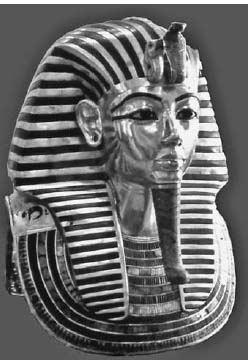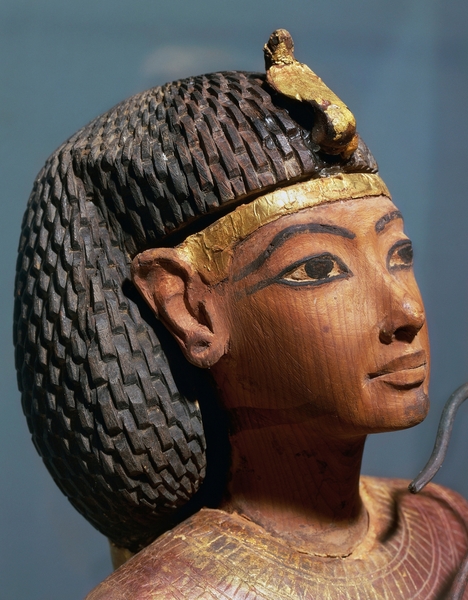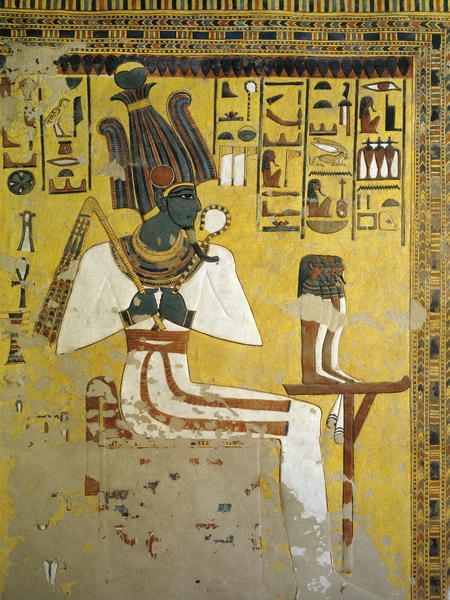The most significant accessory of Ancient Egypt.
Ancient Egypt was one of the most powerful empires of its time, known for its riches as well as its advanced knowledge on architecture and agriculture. Although not often the main topic, fashion was also an essential part of Ancient Egyptian culture. From head to toe, each component worn represented their wealth and status with certain details symbolizing principal elements such as animals, gods and the region they lived upon.
A vital component of wardrobe for royalty was the headdress. It that was both indicative of status and retained extreme symbolic value. For the numerous amount of headdresses made, all were given a unique symbolic significance and purpose. While some signified the area of which the Pharaoh ruled, others represented characteristics important to royalty. More so, some headdresses were only worn for important occasions and ceremonies. With so many to choose from, these named few are known as the most important and recognizable headdresses; The Pshent, the Hedget, the Deshret, the Khepresh, the Nemes, the Hemhemet, the Atef, the Flat crown, and the Urseus.
1.Regional
The Hedget, also known as the White crown symbolized the rule over Upper Egypt. The Deshret, in other words the Red Crown symbolized the rule over Lower Egypt. The Pshent (image 1) was a combination of both Hedget and Deshret both in its appearance and significance as it was symbolic of power over both Upper and Lower Egypt. The Nemes headdress (see image 2.), the most recognized and famed headdress, was worn by Pharaohs that ruled between the Old Kingdom and the New Kingdom. It draped over the shoulders, surrounded the temple and had a “long tail center” symbolizing the tail of a lion1.
2. Ceremonial
For ceremonial purposes the Pharaohs would wear the Kephresh, the war or blue crown that symbolizes “military power or when going in war”. The Atef crown, adorned with ostrich feathers on both sides was worn during religious ceremonies. The Hemhemet was a ceremonial crown as well representing the run and rebirth. However this crown was rarely worn as its large scale made it hard for Pharaoh to keep their head up.
3. Queens and others.
For Queens, they wore the Falcon/Vulture headdress symbolizing the act of protection. They also wore the Flat crown, famously adorned by queen Nerfeti to complement the symmetry of her face. The Urseus, worn by both female and male pharaohs, was a gold band with a cobra on the front symbolizing power. The Urseus was worn alone or accompanied other headdresses (image 3) .
Deities were also depicted wearing headdresses, such as the Atef, worn by Osiris the god of death (see image 4.). Considering that only gods, goddesses, and royalty were capable of wearing headdress makes them extremely sacred and ultimate accessory symbolic of the highest power.
The significance of headresses didn’t crumble down with Ancient Egypt. Its importance has been passed on through generations and has spread to different parts of the world. Whether it be the Crown Jewels of England, or Swazilands “tribal chief’s headdress of black ostrich feathers”, headresses are emblematic of power, culture and royalty making them the most significant accessory there is.
1.The lion was a complex symbol to the ancient Egyptians, capable of representing alternately danger and chaos or protection and the defeat of chaos. It was a secondary attribute of several gods, and of the king as well. Always, it represented power and vitality, and depending upon context it could be a worthy foe, a capable defender, or a fierce avenger.”




Work Cited
Websites:
- “Crowns of Egypt.” Crowns of Egypt & Headdreses of Egyptian Gods ***, www.landofpyramids.org/crown-of-egypt.htm.
- Fassbender, Michael. “Symbolism of the Lion in Ancient Egypt.” Michael Fassbender, michaeltfassbender.com/nonfiction/ancient-history/symbolism-of-the-lion-in-ancient-egypt.
- Parks, Michael. “Amid Animal Skins and Family Pride, a Youth Becomes Swazi King.” Los Angeles Times, Los Angeles Times, 27 Apr. 1986, www.latimes.com/archives/la-xpm-1986-04-27-mn-24006-story.html.
Books:
- “A History in Fashion.” A History of Fashion, by J. Anderson. Black and Madge Garland, Black Cat, 1990, pp. 37–38.
- “A Survey of Historic Costume: Instructor’s Guide.” A Survey of Historic Costume: Instructor’s Guide, by Phyllis G. Tortora and Keith Eubank, Fairchild Publications, 1998, pp. 45–46.
- “Symbolism of the Lion in Ancient Egypt.” Michael Fassbender, michaeltfassbender.com/nonfiction/ancient-history/symbolism-of-the-lion-in-ancient-egypt/.
- “The Worldwide History of Dress.” The Worldwide History of Dress, by Patricia Rieff Anawalt, Thames & Hudson, 2007, pp. 38–41.
“20,000 Years of Fashion.” 20,000 Years of Fashion, by Francois Boucher, 1987, pp. 46–47.
Images:
- “Egypt, Ancient Thebes, Valley of the Queens, mural of Ramses III and god Anubis.” Bridgeman Images: DeAgostini Library, edited by Bridgeman Images, 1st edition, 2014. Credo Reference, https://ezproxy.capilanou.ca/login?url=https://search.credoreference.com/content/entry/bridgemandeag/egypt_ancient_thebes_valley_of_the_queens_mural_of_ramses_iii_and_god_anubis/0?institutionId=6884. Accessed 21 Sep. 2019.
- “Ancient Egypt (C. 10,000 B.C.E. 525 B.C.E.).” A Brief History of Egypt, Arthur Jr. Goldschmidt, Facts On File, 1st edition, 2009. Credo Reference, https://ezproxy.capilanou.ca/login?url=https://search.credoreference.com/content/entry/fofbe/ancient_egypt_c_10_000_b_c_e_525_b_c_e/0?institutionId=6884. Accessed 21 Sep. 2019.
- “Egypt, Luxor, Ancient Egypt Museum, gilded wood ushabti figure, close-up.” Bridgeman Images: DeAgostini Library, edited by Bridgeman Images, 1st edition, 2014. Credo Reference, https://ezproxy.capilanou.ca/login?url=https://search.credoreference.com/content/entry/bridgemandeag/egypt_luxor_ancient_egypt_museum_gilded_wood_ushabti_figure_close_up/0?institutionId=6884. Accessed 21 Sep. 2019.
- “Egypt, Thebes, Luxor, Valley of the Queens, Tomb of Nefertari, Antechamber to burial chamber, Mural paintings, Osiris, Red belt symbolizes assimilation of Osiris and Nefertari.” Bridgeman Images: DeAgostini Library, edited by Bridgeman Images, 1st edition, 2014. Credo Reference, https://ezproxy.capilanou.ca/login?url=https://search.credoreference.com/content/entry/bridgemandeag/egypt_thebes_luxor_valley_of_the_queens_tomb_of_nefertari_antechamber_to_burial_chamber_mural_paintings_osiris_red_belt_symbolizes_assimilation_of_osiris_and_nefertari/0?institutionId=6884. Accessed 21 Sep. 2019.
